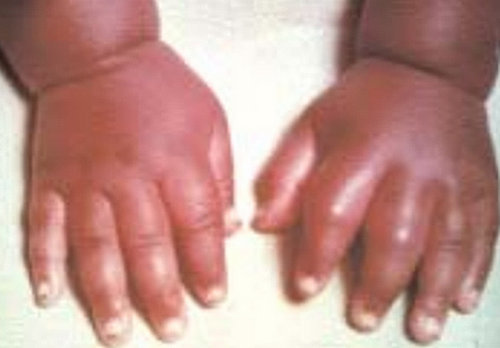Dactylitis pertains to inflammation of the joints in the fingers and toes.
What is sausage finger syndrome? It is sometimes called a sausage toe or finger because the digits look like sausages because of inflammation. In severe cases, it can make your fingers rigid that you can’t even make a fist.
If you are suffering from dactylitis, it can indicate other serious health issues. You could be suffering from arthritis, sickle cell anemia, or ankylosing spondylitis. (1)
Dactylitis causes
There are various reasons for dactylitis and the common causes include the following:
- Dactylitis Psoriatic Arthritis – It is an autoimmune disease causing the immune system to attack healthy tissues. It causes pain and inflammation, especially to the joints and tendon sheaths.
- Dactylitis Rheumatoid Arthritis – Rheumatoid arthritis is an autoimmune disorder, which causes the immune system to attack the joints. As a result, the patient experiences severe pain around the joints. The joints get inflamed and due to severe swelling, the fingers and toes look like sausage. It affects the hands, wrist, feet, knees, elbows, and ankles. (1, 2)
- Reactive Arthritis – This is caused by reaction in some parts of the body. It could be an infection in the urinary tract, genitals, or intestines. Reactive arthritis is usually caused by some types of bacteria such as salmonella, Yersinia, shigella, and campylobacter. Reactive arthritis causes stiffness, urinary tract problems, and inflammation of the eyes.
- Dactylitis Sickle Cell – Dactylitis is the first symptom of sickle cell disease, especially in babies. On the positive note, Dactylitis does not cause any damage to the child’s body. (3)
 Image 1 : Dactylitis in infant with sickle cell disease
Image 1 : Dactylitis in infant with sickle cell disease
Picture Source : img.medscape.com

Picture 1 : Sausage-like fingers in a patient with psoriatic arthritis
Photo Source : www.healthline.com
What are the symptoms of dactylitis?
The symptoms can appear abruptly or may take a few days before they start to develop. The symptoms vary depending on the cause. The primary symptoms include swelling and pain in the digits, the affected part of the body is difficult to move. Sometimes, you cannot move your digit or even make a fist. The joints feel warm.
Accompanying symptoms include fever, shortness of breath, fatigue and visual disturbances. Dactylitis caused by psoriatic arthritis causes the individual digits to swell differently. On the other hand, rheumatoid arthritis causes symmetric pattern of swelling in various parts of the body. (3, 4)
When you should call out for help?
If you are having an extremely high fever and unbearable pain, then you should immediately ask for help. You should see your doctor right away if the pain won’t go away despite taking pain reliever at home. If the problem is not treated immediately, it could lead to severe conditions like pulmonary hypertension, chronic renal failure, decrease immune reaction, secondary infections, and stroke. (5)
How is dactylitis diagnosed?
A lot of factors could lead to dactylitis. To accurately diagnose the condition of the patient, the doctor will conduct a series of test. Physical assessment and interview of past medical and surgical history will be done to rule out what could possibly be causing dactylitis.
The doctor will thoroughly assess the location of the pain and swelling, particularly on the joints, toes, and fingers. An imaging test such as x-ray and magnetic resonance imaging (MRI) will be ordered to accurately view the affected parts of the body.
If the doctor is suspecting gout or rheumatoid arthritis, he will order laboratory tests like joint fluid test and additional blood test. It is important to correctly and immediately diagnose the condition that causes dactylitis. Failure to do so could lead to permanent joint deformity and eventually loss of function of a particular body parts. (5, 6)
Dactylitis Differential Diagnosis
Dactylitis or sausage-shaped fingers could indicate a particular type of psoriatic arthritis minus the rheumatoid factor activity. If the joint pain progresses along the phalanges of fingers along with soft tissue swelling, it is a confirmatory assessment that the patient is indeed suffering from dactylitis. (7)
Dactylitis Treatment
The treatment approach for dactylitis varies depending on the underlying cause. If it is caused by psoriatic arthritis, unfortunately there is no available cure. The best thing to do is to manage the symptoms or so-called symptomatic relief.
The doctor will prescribe non-steroidal anti-inflammatory drugs as well as disease-modifying anti-rheumatic drugs. These drugs can alleviate pain and somehow decrease the inflammation. They also prevent damage to the joints. (7)
If the cause of dactylitis is rheumatoid arthritis, the doctor will prescribe a variety of medications such as corticosteroids, disease modifying anti-rheumatic drugs, JAK (Janus Kinase) inhibitors, and genetically-engineered proteins. If the condition is extremely severe, a joint replacement surgery will be performed. However, this should be the last resort. It would only be performed if all other remedies failed.
If the dactylitis is caused by reactive arthritis, the doctor will treat it using antibiotics, corticosteroids, non-steroidal anti-inflammatory drugs, and rheumatoid arthritis drugs. The patient is also advised to have physical therapy and exercise to significantly improve the functions of the joints and reduce stiffness. (8)
Other forms of dactylitis
- Blistering distal dactylitis – It is an inflammation on the distal part of the fingers. It usually affects the children, especially between six months and four years. It affects the fat pad of the finger. There is pain and inflammation, which makes it extremely difficult to move your fingers. It is caused by group A haemolytic streptococcus and Staph aureus. The treatment approach for this type of dactylitis include warm compress, oral antibiotics, and incision and drainage.
- Tuberculous dactylitis – It does not affect the flesh of the fingers and toes, but rather affect the bone structure of the hands and feet. It causes severe pain, especially in the short tubular bones. (8,9)
Pain management for dactylitis at home
Mild episodes of dactylitis can be treated at home. In case of pain and discomfort, the patient should take over the counter pain reliever such as ibuprofen. You should also increase your intake of fluids, especially water and fresh fruit juices. A warm compress on the swollen area constricts the blood vessels, which helps alleviate pain and discomfort. (10)
References:
- http://www.healthline.com
- https://en.wikipedia.org
- www.ncbi.nlm.nih.gov
- diseasespictures.com
- www.webmd.com
- https://patient.info
- www.mdedge.com
- howshealth.com
- www.epainassist.com
- www.rightdiagnosis.com



